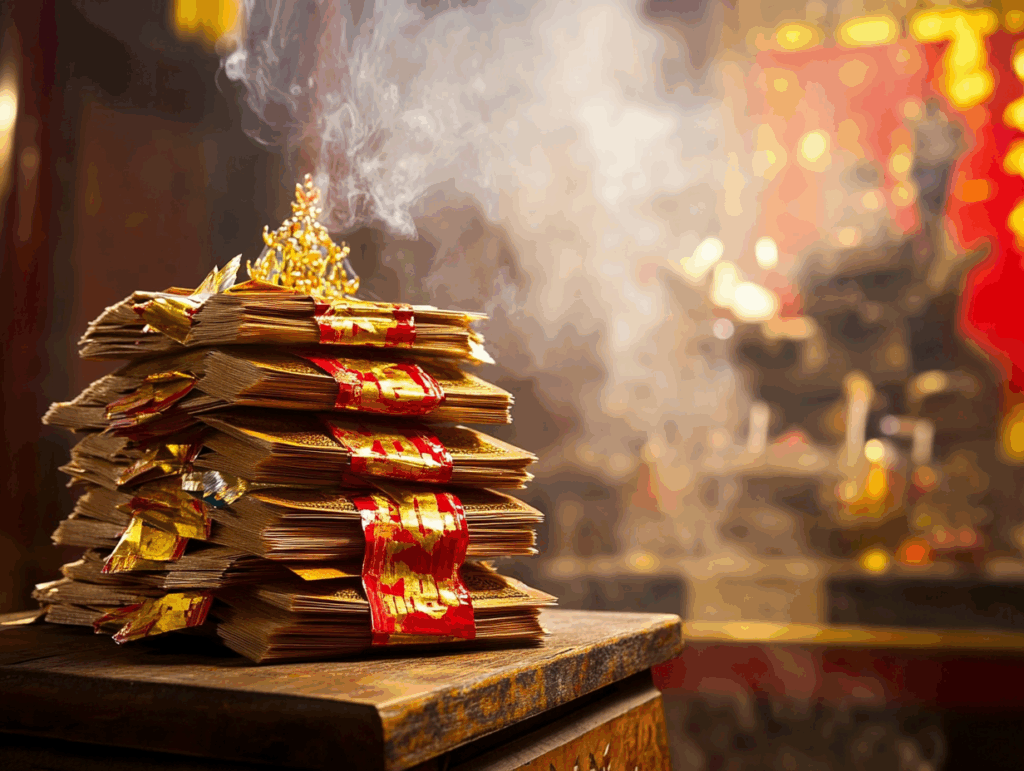Spirit Money: Traditions, Meanings, and Modern Practices

Spirit money, also called joss paper or ghost money, plays a key role in many East Asian spiritual traditions. People believe it helps provide wealth and comfort to ancestors and wandering spirits in the afterlife. This article explains the origins, types, rituals, and modern changes surrounding spirit money. The language stays simple, uses the active voice, and keeps sentences short. What is Spirit Money(Joss Paper)? Joss Paper refers to special paper items burned during traditional ceremonies. Families believe these offerings reach the spirit world, where they give money and goods to deceased loved ones. People use it during funerals, ancestor worship days, Ghost Month, and temple ceremonies. History and Origins Ancient Chinese Beliefs Ancient Chinese communities believed the afterlife mirrored the human world. The dead needed food, clothing, and money. Families offered real items in early times but switched to paper to avoid waste and cost. Spread Across Asia The practice spread to Taiwan, Singapore, Vietnam, Malaysia, and other parts of Asia. Each region developed unique designs and traditions, yet the purpose remained the same: to support spirits in the other world. Types of Spirit Money Gold and Silver Paper Gold paper is typically reserved for gods and deities, while silver paper is used for ancestors. People fold the sheets into shapes before burning them. Hell Bank Notes These look like paper money with large denominations. Families burn them to send financial support to their loved ones in the spirit realm. Paper Goods Beyond money, people create paper houses, clothes, jewellery, and even paper cars or electronics. Burning these symbolises sending comfort and luxury to ancestors. Rituals and Practices Preparing Offerings Families clean ancestor altars, prepare food, tea, and incense, and set up tables outside their homes. They place spirit money with these offerings to show respect. Burning Ceremony They fold the paper and place it in a safe container or metal bin. Once lit, people believe smoke carries the money to spirits. They bow or pray during the burning, asking for blessings and protection. Community Rituals Temples organise larger ceremonies where families gather to burn offerings together. These events build a sense of unity and shared respect for the dead. Symbolism of Joss Paper Spirit money(Joss Paper) represents more than wealth. It symbolises: Modern Adaptations Digital Spirit Money With technology, people now send virtual joss paper through apps and websites. This allows offerings without smoke or fire hazards. Eco-Friendly Alternatives Many communities switch to environmentally friendly paper or set limits on burning to reduce pollution. Personalized Designs Families order custom-made spirit money with names or messages, making offerings more personal and meaningful. Common Occasions for Spirit Money Joss Paper Around the World In Singapore and Malaysia, people burn spirit money during large community events. In Taiwan, temples hold grand ceremonies with music and prayers. In Vietnam, families offer paper money during Tết and other ancestral rites. Each place keeps the same goal: caring for spirits beyond this world. Conclusion Joss Paper remains a strong tradition in many cultures. It reflects love, respect, and the wish to keep connections with ancestors alive. Whether through burning paper offerings or using digital methods, families continue this practice to honour the past and seek harmony with the unseen world.
Ghost Month 2025: Traditions, Beliefs, and Modern Practices

Ghost Month begins on the first day of the seventh lunar month and lasts for thirty days. The most important day is the fifteenth day, often called the Hungry Ghost Festival. Families prepare rituals and offerings to honour ancestors and calm wandering spirits. Many believe this month strengthens the connection between the living and the spiritual world. Origins and Cultural Significance Taoist Beliefs Taoist teachings describe the seventh month as the time when the gates of the underworld open. Spirits are free to roam, visiting loved ones or seeking food and offerings. Taoist rituals focus on balance between worlds, protection, and gratitude to ancestors. Buddhist Influence Buddhist stories tell of Maudgalyayana saving his mother from the realm of hungry ghosts through prayers and offerings. This tale inspires many of the ceremonies people perform during Ghost Month to help spirits find peace. Key Traditions Offerings Families place food, fruits, tea, and incense on outdoor tables or altars. They believe these offerings feed spirits and show respect to ancestors. Burning Joss Paper People burn joss paper or “spirit money” as a symbolic way to send wealth and goods to the afterlife. Some also burn paper houses, clothes, or cars for their loved ones. Street Performances Communities organise Getai shows with music and dance to entertain both spirits and humans. The first row of seats is kept empty for unseen guests. Common Taboos During Ghost Month, many avoid risky or spiritually sensitive activities. Common taboos include: People follow these customs to stay safe and avoid angering spirits. Modern Adaptations In 2025, traditions evolve with technology and environmental awareness: Ghost Month Around the World Countries like China, Taiwan, Singapore, Malaysia, and Vietnam celebrate Ghost Month with unique customs. Some focus on temple ceremonies, while others organise street parades, floating lanterns, or community feasts. Why Ghost Month Matters Ghost Month reminds people to honour their ancestors and care for the unseen spirits around them. It strengthens family bonds, teaches gratitude, and helps maintain harmony between the living and the spiritual world. Conclusion Ghost Month blends tradition, belief, and community connection. Families continue these practices to show respect for ancestors and to keep balance between worlds. Whether through traditional rituals or modern adaptations, the meaning of Ghost Month remains strong in 2025.
What is the Hungry Ghost Festival?

The Hungry Ghost Festival, also known as Zhongyuan Festival (中元节) in Taoism and Yulanpen Festival (盂兰盆节) in Buddhism, is a traditional East Asian celebration that honors deceased ancestors and appeases wandering spirits. It falls on the 15th day of the seventh lunar month, which typically occurs in August or early September on the Gregorian calendar. In 2025, people will observe the Hungry Ghost Festival on August 12. Unlike other festivals that focus on joyous reunions with spirits (like Qingming or Obon), the Hungry Ghost Festival is rooted in the belief that during this time, the gates of the underworld open, allowing spirits to roam freely in the human world. Historical and Cultural Background Origins in Taoism and Buddhism The Hungry Ghost Festival has deep roots in both Taoist and Buddhist traditions. In Taoism, it is part of a trio of important festivals during the Three Yuan Festivals (上元、中元、下元). The seventh month, also known as the Ghost Month, is believed to be a time when yin energy is strong and the spirits of the dead return. In Buddhism, the festival is connected to the Ullambana Sutra, which tells the story of Maudgalyayana (Mulian), a disciple of the Buddha, who tries to save his mother from the realm of hungry ghosts by offering food and prayers through the monastic community. Spread Across Asia Although the core beliefs are similar, the Hungry Ghost Festival is widely spread and celebrated in different ways in countries such as China, Taiwan, Singapore, Malaysia, Vietnam, and Thailand, each with its own customs and rituals. Key Beliefs and Symbolism Who Are the Hungry Ghosts? In Chinese folk religion, hungry ghosts (餓鬼) are spirits of people who died in tragic or unnatural ways, or those who were not given a proper burial or offerings. These ghosts are said to suffer from insatiable hunger and emotional torment. They are often depicted as having tiny throats and bloated stomachs, symbolising their inability to satisfy their cravings—both for food and emotional closure. Purpose of the Festival The festival serves several purposes: Traditional Rituals and Practices Offerings of Food and Joss Paper One of the most common practices during the Hungry Ghost Festival involves preparing lavish food offerings for both ancestors and wandering spirits. Families place these offerings on altars or tables outside their homes or businesses. People burn joss paper—also known as spirit money or ghost money—as symbolic offerings. They also burn paper replicas of items like clothes, houses, phones, and even cars, believing these will reach loved ones in the spirit world. Public Performances In many communities, Getai performances—lively shows featuring music, comedy, and opera—are held to entertain both the living and the spirits. The front row of seats is usually left empty as a sign of respect for the ghostly audience. Floating Lanterns and Water Rituals In some regions, people release lotus-shaped lanterns on rivers or lakes to guide lost spirits and prevent them from causing harm. This tradition is especially common in Buddhist communities.In some regions, people release lotus-shaped lanterns on rivers or lakes to guide lost spirits and prevent them from causing harm. This is especially common in Buddhist communities. Modern Adaptations of the Festival Digital Joss Paper and Online Altars In 2025, the tradition has taken on new forms. With increasing environmental awareness and the rise of digital platforms, people now use digital joss paper offerings and online ancestor altars to honor the dead in a more eco-conscious way. These practices offer convenience, especially for those living far from ancestral homes or in urban areas. Virtual Performances and E-Ceremonies Some communities now stream virtual Getai shows or conduct rituals via Zoom or YouTube, making the festival more accessible to global audiences while preserving its cultural essence. Cultural Taboos and Superstitions The Hungry Ghost Month is considered a spiritually sensitive time, and there are many taboos people follow to avoid bad luck or spirit disturbances: These taboos are not universally followed but are taken seriously by those who hold traditional beliefs. The Hungry Ghost Festival in Singapore In Singapore, the festival is widely celebrated among the Chinese community, especially by Taoists and Buddhists. Large-scale Getai stages, incense-burning ceremonies, and street offerings appear in neighbourhoods like Chinatown, Geylang, and Toa Payoh. The Singaporean government designates specific areas for burning joss paper, and many citizens join community-led rituals organised by local temples and clan associations. Why the Festival Still Matters Today Even in a fast-paced, modern world, the Hungry Ghost Festival remains an important reminder of filial piety, respect for ancestors, and the unseen spiritual dimensions of life. For many, it’s not just about appeasing spirits but about maintaining cultural identity and continuity across generations. Conclusion The Hungry Ghost Festival is a deeply spiritual and culturally rich tradition that continues to evolve with time. Whether through traditional rituals, digital offerings, or eco-friendly practices, the essence of the festival remains: to honor the dead, accumulate good karma, and keep the harmony between the living and the spiritual world.
The use of digital joss paper in 2025

A Modern Take on an Ancient Ritual In 2025, the use of digital joss paper has grown rapidly as more people seek sustainable and convenient ways to honor their ancestors—especially during traditional events like the Hungry Ghost Festival. While the act of burning spirit money has been practiced for generations, environmental concerns and changing lifestyles have encouraged a shift toward digital alternatives. Why Digital Joss Paper Is Gaining Popularity The seventh month of the lunar calendar, known as ghost month, is traditionally when families make offerings to wandering spirits. However, burning joss paper in densely populated cities like Singapore can pose safety hazards and contribute to air pollution. In response, digital offerings provide a safe, clean, and symbolic method to continue these meaningful rituals. In this new digital age, people can now continue their tradition without polluting the air and still show respect to their ancestors. Features of Digital Spirit Offerings Today’s digital joss paper platforms allow users to “burn” paper offerings online through mobile apps or websites. Many feature animated flames, customizable items (like houses, gold ingots, and luxury goods), and personal messages to ancestors. These virtual tools preserve the cultural intent while adapting to modern needs. Embracing Digital Offerings for Hungry Ghost Festival 2025 This year’s Hungry Ghost Festival 2025 is expected to see a significant increase in digital participation. Young adults, global families, and environmentally conscious individuals are leading the way in adopting this eco-friendly alternative. Whether you’re in Asia or abroad, honouring your ancestors with digital spirit money is now easier and more accessible than ever. Honoring the Past, the Modern Way The rise of digital joss paper in 2025 shows that tradition and innovation can go hand in hand. With respect at its core, this evolving practice offers a meaningful way to stay connected to cultural heritage—without sacrificing sustainability or convenience.